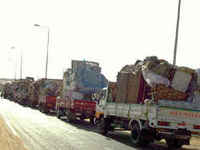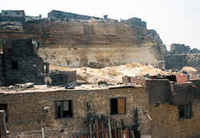Egypt: Out of the slum and into joblessness
CAIRO, 17 November 2009 (IRIN) - When government workmen came in a truck to take Ahmed Mohamed's furniture to his new home just outside Cairo, the 32-year-old fisherman said “We were given beautiful homes, but they’re good for nothing. What can a fisherman like me do in the desert?”
CAIRO, 17 November 2009 (IRIN) - When government workmen came in a truck to take Ahmed Mohamed’s furniture to his new home just outside Cairo, the 32-year-old fisherman was overjoyed: His dream of quitting the slum where he had lived for years seemed to be coming true.
However, when he got to a new residential area called 6 October, 50km southwest of the city centre, he realized there was a problem: “We were given beautiful homes, but they’re good for nothing. What can a fisherman like me do in the desert?” Mohamed, whose former slum of Istable Antar was near the River Nile, told IRIN.
There are some 1,221 slums in Egypt (76 in Cairo), and around 20 million people, a quarter of the population, live in them, according to the country’s Central Agency for Public Mobilization and Statistics (CAPMAS).
Between 1993 and 2007, the government spent the equivalent of US$727 million developing some slums and relocating the residents of others, according to CAPMAS.
But the plight of slum-dwellers hit the headlines in September 2008 when a rockslide caused the deaths of some 100 residents of al-Dweiqa slum
, in eastern Cairo, part of the al-Muqattam cliffs on the edge of the city.
The deadliest seven
Seven of Cairo’s slums were identified by the government as the most dangerous in terms of health and safety - built on or under crumbling cliff-edges.
The 2008 rockslide tragedy prompted the government to provide the estimated 19,000 families living in these seven slums with new housing on the outskirts of Cairo.
To date, 4,000 families have been relocated, and Mohamed was one of the “lucky ones”.
But he now travels up to 50km to get to his boat and fishing gear on the Nile. With a weekly income of less than LE200 (US$36), Mohamed bemoaned his travelling costs and the time lost travelling.
“Almost a quarter of my income goes on transport… I work three days a week now.”
Many of the breadwinners of relocated families jointly rent small rooms near their places of work in the capital and visit their families in the new flats only on weekends.
Jobless
While few slum-dwellers are fishermen like Mohamed, most said moving outside the capital left them jobless.
Abdel Ra’ouf Abdel Monem, another resident of Istable Antar, earns a living by roaming the streets of Cairo on a donkey-drawn cart collecting scrap metal and plastic which, on an average day, he sells for about LE40 ($7). He and many others like him fear they will be cut off from their source of income if and when they are moved.
“Our jobs are here, our life is here. Why should we move?... The government can’t put us in the desert and then claim to have solved our problem,” he said.


